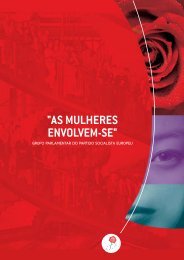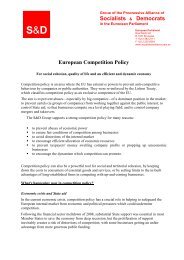Politics of the past: the use and abuse of history - Socialists ...
Politics of the past: the use and abuse of history - Socialists ...
Politics of the past: the use and abuse of history - Socialists ...
Create successful ePaper yourself
Turn your PDF publications into a flip-book with our unique Google optimized e-Paper software.
having always been victims, trying to create taboos concerning<br />
certain aspects <strong>of</strong> <strong>the</strong>ir country’s <strong>history</strong>;<br />
R. <strong>the</strong>se forces are trying to monopolize <strong>the</strong> struggle for freedom on<br />
<strong>the</strong>ir side <strong>and</strong> to portray <strong>the</strong>mselves as <strong>the</strong> true defenders <strong>of</strong> <strong>the</strong><br />
‘national’ interest while some <strong>of</strong> <strong>the</strong>m even today openly defend <strong>the</strong><br />
Spanish dictator Franco as <strong>the</strong> saviour <strong>of</strong> catholic religion from<br />
communism <strong>and</strong> o<strong>the</strong>rs revitalize ethnic conflicts <strong>of</strong> <strong>the</strong> twenties <strong>of</strong><br />
<strong>the</strong> 20 th century;<br />
Requests <strong>of</strong> <strong>the</strong> Europe Commission that future hearings<br />
shall – notwithst<strong>and</strong>ing o<strong>the</strong>r issues – cover <strong>the</strong> following<br />
items:<br />
1. Criteria to compare <strong>and</strong> to distinguish between totalitarian <strong>and</strong><br />
authoritarian regimes, <strong>the</strong>ir dimension <strong>and</strong> <strong>the</strong> intensity <strong>of</strong> repression.<br />
2. An investigation into <strong>the</strong> different ideologies <strong>of</strong> <strong>the</strong> totalitarian<br />
<strong>and</strong> authoritarian regimes <strong>of</strong> <strong>the</strong> 20 th century in Europe <strong>and</strong> <strong>the</strong> differences<br />
<strong>and</strong> similarities in executing power <strong>and</strong> treatment <strong>of</strong> political<br />
opponents as well as social entities defined as “enemies” or<br />
“racially inferior”.<br />
Questions to be answered:<br />
2a. What were <strong>the</strong> ideological specificities to define “enemies” or<br />
“racial inferior” groups inside or outside society? Is <strong>the</strong>re a “totalitarian<br />
way <strong>of</strong> thought”?<br />
2b. What are especially <strong>the</strong> similarities <strong>and</strong> differences between<br />
<strong>the</strong> Nazi- <strong>and</strong> <strong>the</strong> Stalinist system with reference to<br />
- <strong>the</strong> roles <strong>of</strong> <strong>the</strong> communist <strong>and</strong> Nazi party organization<br />
- <strong>the</strong> extent <strong>of</strong> control <strong>of</strong> everyday life<br />
- organizing mass loyalty<br />
- <strong>the</strong> modus oper<strong>and</strong>i <strong>of</strong> <strong>the</strong> respective terror apparatus<br />
- <strong>the</strong> treatment <strong>of</strong> political opponents<br />
- <strong>the</strong> treatment <strong>of</strong> national minorities<br />
163<br />
Helmut Kuhne, Miguel Angel Martinez,<br />
Justas Paleckis, Józef PiniorErich Fröschl





